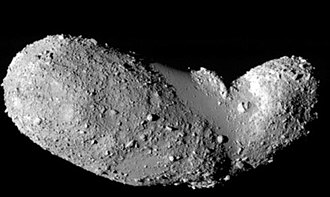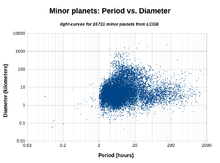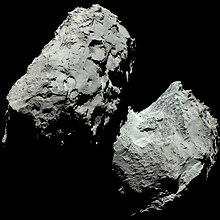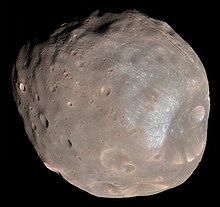Rubble pile

Inastronomy,arubble pileis acelestial bodythat consists of numerous pieces of debris that have coalesced under the influence ofgravity.Rubble piles have low density because there are large cavities between the various chunks that make them up.
The asteroidsBennuandRyuguhave a measured bulk density which suggests that their internal structure is a rubble pile.[1][2]Manycometsand most smallerminor planets(<10 km in diameter) are thought to be composed of coalesced rubble.[3][4]
Minor planets
[edit]This sectionneeds additional citations forverification.(March 2024) |

Most smallerasteroidsare thought to be rubble piles.[3]
Rubble piles form when an asteroid or moon (which may originally be monolithic) is smashed to pieces by an impact, and the shattered pieces subsequently fall back together, primarily due to self-gravitation. This coalescing usually takes from several hours to weeks.[5]
When a rubble-pile asteroid passes a much more massive object, tidal forces change its shape.[6]
Scientists first suspected that asteroids are often rubble piles when asteroid densities were first determined. Many of the calculated densities were significantly less than those of meteorites, which in some cases had been determined to be pieces of asteroids.
Many asteroids with low densities are thought to be rubble piles, for example253 Mathilde.The mass of Mathilde, as determined by theNEAR Shoemakermission, is far too low for the volume observed, considering the surface is rock. Even ice with a thin crust of rock would not provide a suitable density. Also, the large impact craters on Mathilde would have shattered a rigid body. However, the first unambiguous rubble pile to be photographed is25143 Itokawa,which has no obvious impact craters and is thus almost certainly a coalescence of shattered fragments.
The asteroid433 Eros,the primary destination ofNEAR Shoemaker,was determined to be riven with cracks but otherwise solid. Other asteroids, possibly including Itokawa, have been found to becontact binaries,two major bodies touching, with or without rubble filling the boundary.
Large interior voids are possible because of the very low gravity of most asteroids. Despite a fineregolithon the outside (at least to the resolution that has been seen with spacecraft), the asteroid's gravity is so weak that friction between fragments dominates and prevents small pieces from falling inwards and filling the voids.
All the largest asteroids (1 Ceres,2 Pallas,4 Vesta,10 Hygiea,704 Interamnia) are solid objects without any macroscopic internal porosity. This may be because they have been large enough to withstand all impacts, and have never been shattered. Alternatively, Ceres and some few other of the largest asteroids may be massive enough that, even if they were shattered but not dispersed, their gravity would collapse most voids upon recoalescing. Vesta, at least, has withstood intact one major impact since its formation and shows signs of internal structure fromdifferentiationin the resultant crater that assures that it is not a rubble pile. This serves as evidence for size as a protection from shattering into rubble.
Comets
[edit]
Observational evidence suggest that thecometary nucleusmay not be a well-consolidated single body, but may instead be a loosely bound agglomeration of smaller fragments, weakly bonded and subject to occasional or even frequent disruptive events, although the larger cometary fragments are expected to be primordial condensations rather than collisionally derived debris as in the asteroid case.[7][8][9][10][11] However,in situobservations by theRosettamissionindicate that it may be more complex than that.[12][clarification needed]
Moons
[edit]
The moonPhobos,the larger of the two natural satellites of the planetMars,is also thought to be a rubble pile bound together by a thin regolith crust about 100 m (330 ft) thick.[13][14]A rubble-pile morphology may point towards anin situorigin of the Martian moons. Based on this, has been proposed that Phobos and Deimos may originate from a single destroyed moon. Alternatively, Phobos may have undergone repeated 'recycling,' having been torn apart into a ring before reaccreting and migrating outwards.[15]
See also
[edit]References
[edit]- ^Data source, reference:Warner, B.D.,Harris, A.W.,Pravec, P.(2009). Icarus 202, 134-146.[16]Updated 2016 September 6. See:www.MinorPlanet.info
- ^Chesley, Steven R.; Farnocchia, Davide; Nolan, Michael C.; Vokrouhlický, David; Chodas, Paul W.; Milani, Andrea; Spoto, Federica; Rozitis, Benjamin; Benner, Lance A.M.; Bottke, William F.; Busch, Michael W.; Emery, Joshua P.;Howell, Ellen S.;Lauretta, Dante S.; Margot, Jean-Luc; Taylor, Patrick A. (2014). "Orbit and bulk density of the OSIRIS-REx target Asteroid (101955) Bennu".Icarus.235:5–22.arXiv:1402.5573.Bibcode:2014Icar..235....5C.doi:10.1016/j.icarus.2014.02.020.ISSN0019-1035.S2CID30979660.
- ^Hayabusa-2: Asteroid mission exploring a 'rubble pile'.Paul Rincon,BBC News.19 March 2019.
- ^abc"About Light Curves".Minor Planet Center.Retrieved24 April2020.
- ^Walsh, Kevin J. (14 September 2018)."Rubble Pile Asteroids".Annual Review of Astronomy and Astrophysics.56(1): 593–624.arXiv:1810.01815.Bibcode:2018ARA&A..56..593W.doi:10.1146/annurev-astro-081817-052013.ISSN0066-4146.S2CID119530506.
- ^Michel, Patrick; Benz, Willy; Tanga, Paolo; Richardson, Derek C. (November 2001). "Collisions and Gravitational Reaccumulation: Forming Asteroid Families and Satellites".Science.294(5547): 1696–1700.Bibcode:2001Sci...294.1696M.doi:10.1126/science.1065189.PMID11721050.S2CID6470148.
- ^Solem, Johndale C.; Hills, Jack G. (March 1996). "Shaping of Earth-Crossing Asteroids by Tidal Forces".Astronomical Journal.111:1382.Bibcode:1996AJ....111.1382S.doi:10.1086/117884.
- ^Weissman, P. R. (March 1986). "Are cometary nuclei primordial rubble piles?".Nature.320(6059): 242–244.Bibcode:1986Natur.320..242W.doi:10.1038/320242a0.ISSN0028-0836.S2CID4365705.
- ^Tidal Disruption of Asteroids and Comets.William Bottke.Southwest Research Institutein Boulder, Colorado. 1998.
- ^Stardust at Comet Wild 2.(PDF) Harold A. Weaver,Science18 JUNE 2004, Vol 304.
- ^Interior of the Cometary Nucleus.University of California, Los Angeles.
- ^Asphaug, E.; Benz, W. (1994). "Density of comet Shoemaker–Levy 9 deduced by modelling breakup of the parent 'rubble pile'".Nature.370(6485): 120–124.Bibcode:1994Natur.370..120A.doi:10.1038/370120a0.S2CID4336930.
- ^Khan, Amina (31 July 2015)."After a bounce, Rosetta's Philae lander serves up cometary surprises".Los Angeles Times.Retrieved11 November2015.
- ^"Phobos is Slowly Falling Apart".NASA.SpaceRef. 10 November 2015.Retrieved11 November2015.[permanent dead link]
- ^"NASA – Phobos".Solarsystem.nasa.gov. Archived fromthe originalon 24 June 2014.Retrieved4 August2014.
- ^Madeira, Gustavo; Charnoz, Sébastian; Zhang, Yun; Hyodo, Ryuki; Michel, Patrick; Genda, Hidenori; Giuliatti Winter, Silvia (April 2023)."Exploring the Recycling Model of Phobos Formation: Rubble-pile Satellites".The Astronomical Journal.165(4): 161.arXiv:2302.12556.Bibcode:2023AJ....165..161M.doi:10.3847/1538-3881/acbf53.
- ^Warner, Brian D.; Harris, Alan W.; Pravec, Petr (July 2009). "The asteroid lightcurve database".Icarus.202(1): 134–146.Bibcode:2009Icar..202..134W.doi:10.1016/j.icarus.2009.02.003.
External links
[edit]- Close-up images of Itokawa, a rubble pile asteroid
- NASA Astronomy Picture of the Day: Saturn's Moon Calypso, another possible rubble pile (17 February 2010)
- Hyper-Velocity Impacts on Rubble Pile Asteroidspdf online @ kent.ac.uk
